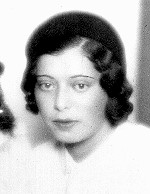
Helene Melanie Lebel
Helene Melanie Lebel was one of approximately 250,000 people murdered by the Nazis because they were physically or mentally disabled.
Download Helene’s easy to read life story
Download Helene’s Welsh language life story
Helene was born on 15 September 1911, and brought up in Vienna, Austria with her younger sister by her Jewish father and Catholic mother. Helene’s father died during World War One when she was just five years old. As she grew up Helene particularly enjoyed swimming and after secondary school she went onto law school.
In 1930, when Helene was just 19 years old, Helene started showing the signs of mental illness. By 1935, she had to give up both her studies and her job as a legal secretary. Helene had a breakdown, was diagnosed as having schizophrenia and put in a psychiatric hospital.
Although Helene’s condition was beginning to improve she was not allowed to return home. Following the Anschluss in 1938 – when Austria was annexed to Germany – Helene was forced to remain in a psychiatric hospital. In August 1940, Helene’s mother was told that Helene had been transferred to a hospital in Germany. However, Helene was in fact taken to a converted prison, in Brandenburg in Germany, where she was gassed. Helene was one of 9,772 people listed as being gassed at the Brandenburg centre in 1940.
You may notice that Helene’s life story is much shorter than other HMDT resources. This is because very little is known about the victims of the T4 forced euthanasia programme. The programme was deliberately carried out covertly to stop the German public from protesting. However, in 1941, as news of the T4 programme leaked out there were protests and opposition. On 3 August 1941 a Catholic Bishop, Clemens von Galen, delivered a passionate sermon in Münster Cathedral attacking the euthanasia programme, which he described as ‘plain murder.’ He spoke of a terrible future for humanity if euthanasia became acceptable for those perceived to be weak.
Under pressure from public opinion, Hitler ordered the closure of the official euthanasia programme. However the murders did not cease, continuing instead in more secretive ways; patients died through drug overdose, or were deliberately starved to death. The organs of many of the victims were removed for scientific research, and the bodies were buried in mass graves.
For more information:
- Read about Berge Kanikanian’s quest to find out more about Aktion T4
- Find out more about Aktion T4 and the Nazi treatment of disabled people
- Read more about Nazi persecution of disabled people.
- This resource was produced with information from the article ‘Helene Melanie Lebel’